The use of technology in english language teaching and learning
Language is essential to communicating amongst mankind. English was chosen to be the global
language by the late 18th century and became the indispensable part of international
communication. Since the evolution of technology, it seems appear to be in anything one could
possibly think of in life, including the pedagogical. Most native learners at present prefer a study
environment which is enhanced by technology as the traditional education methods are unable to
meet what they expected (Gunuc 2013).
Linguist Ahmadi (2017) stated that one of the important components in English learning is that the
teachers' usage of their facilities in class during the learning process. Thus computers are regarded
as an important instructional instrument in language classes in which teachers have convenient
access. The use of technology in studying has been stressed by OECD (Organization for Economic
Co-operation and Development, 2001) as an academically necessity for improving quality in both
teaching and learning. Providing by information and communication technologies (ICTs) like PCs,
smartphones that are connected to the Internet, the lessons are seemingly to be more vivid toward
learners hence making them more motivated.
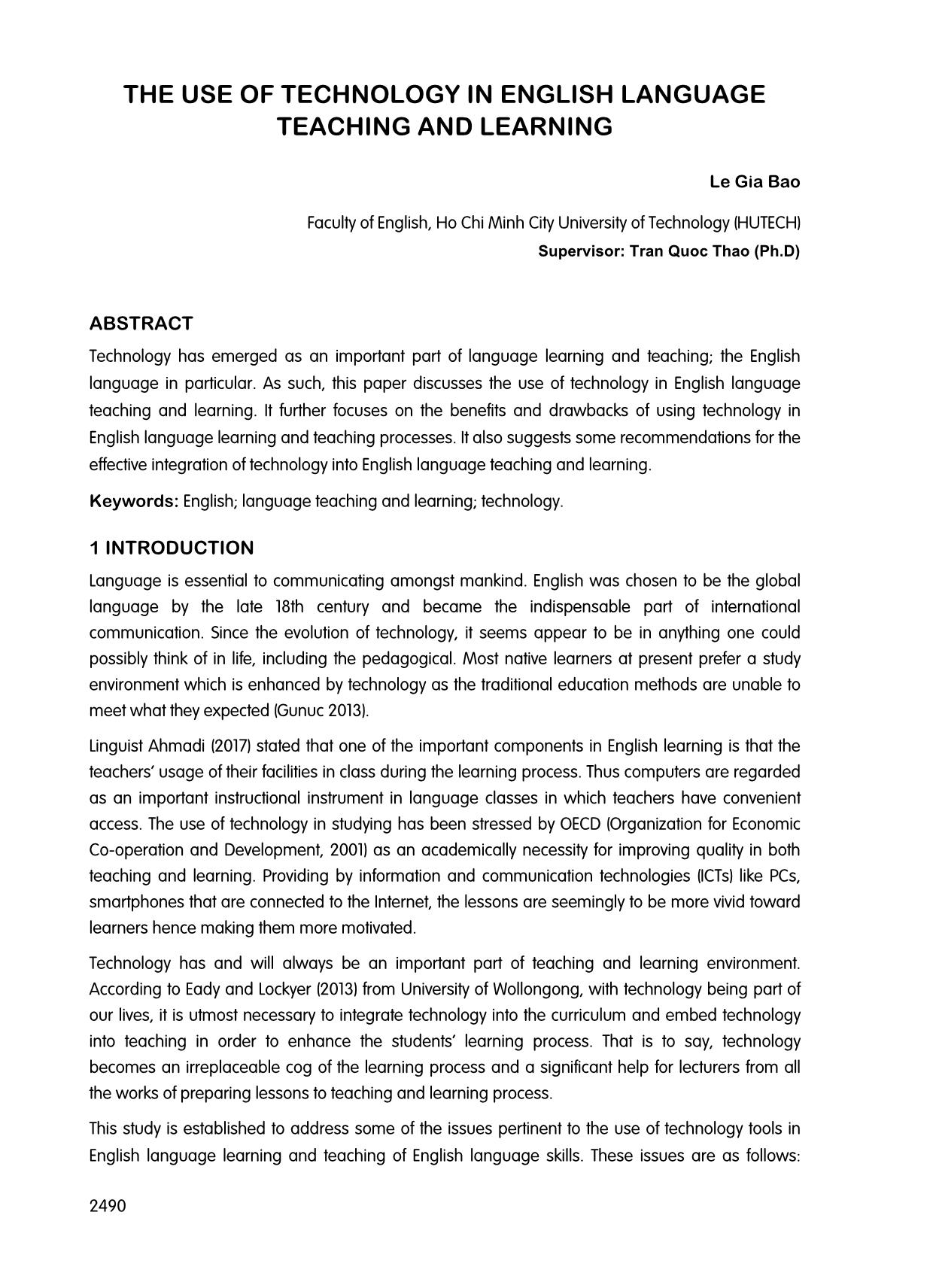
Trang 1
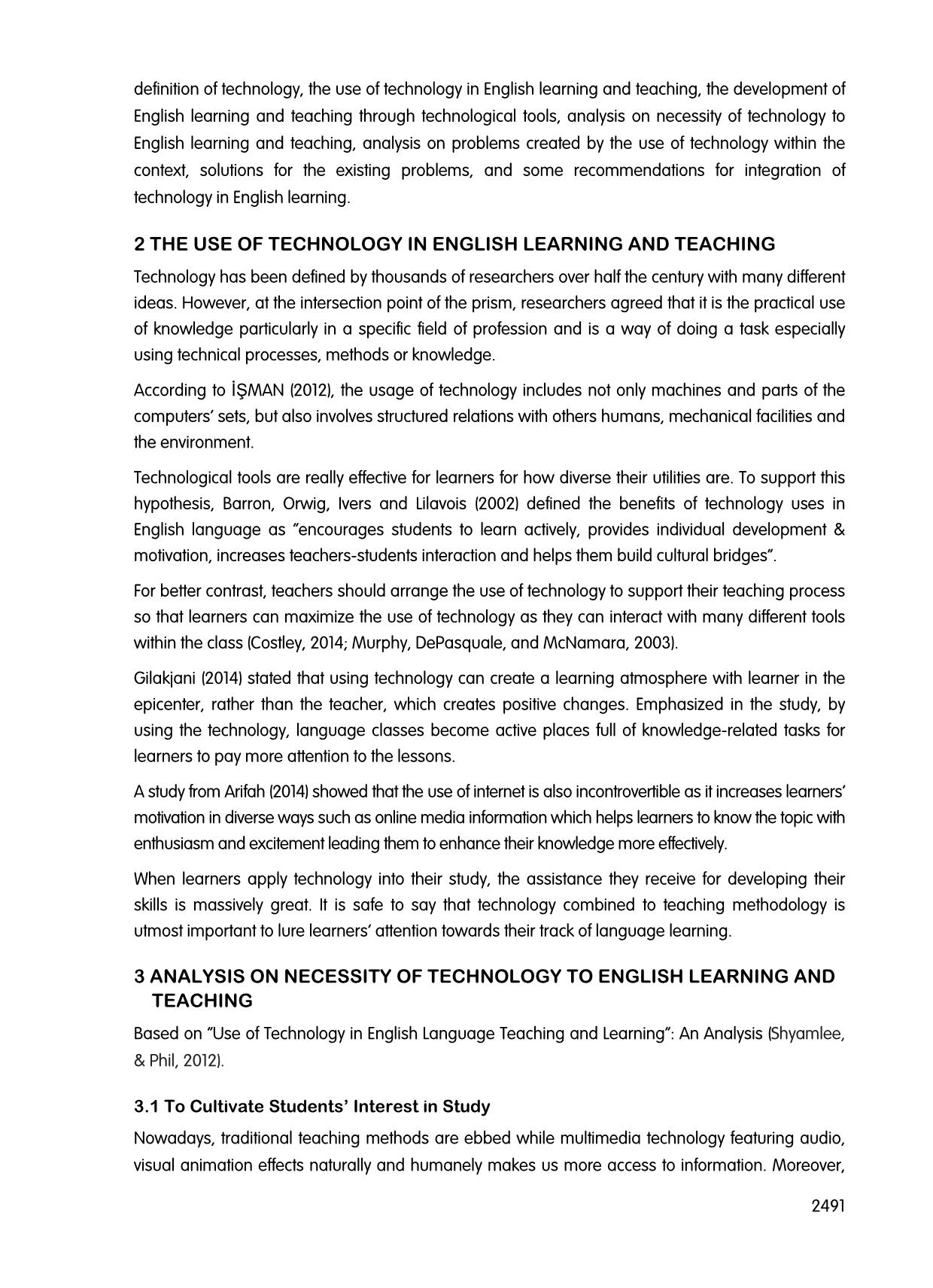
Trang 2
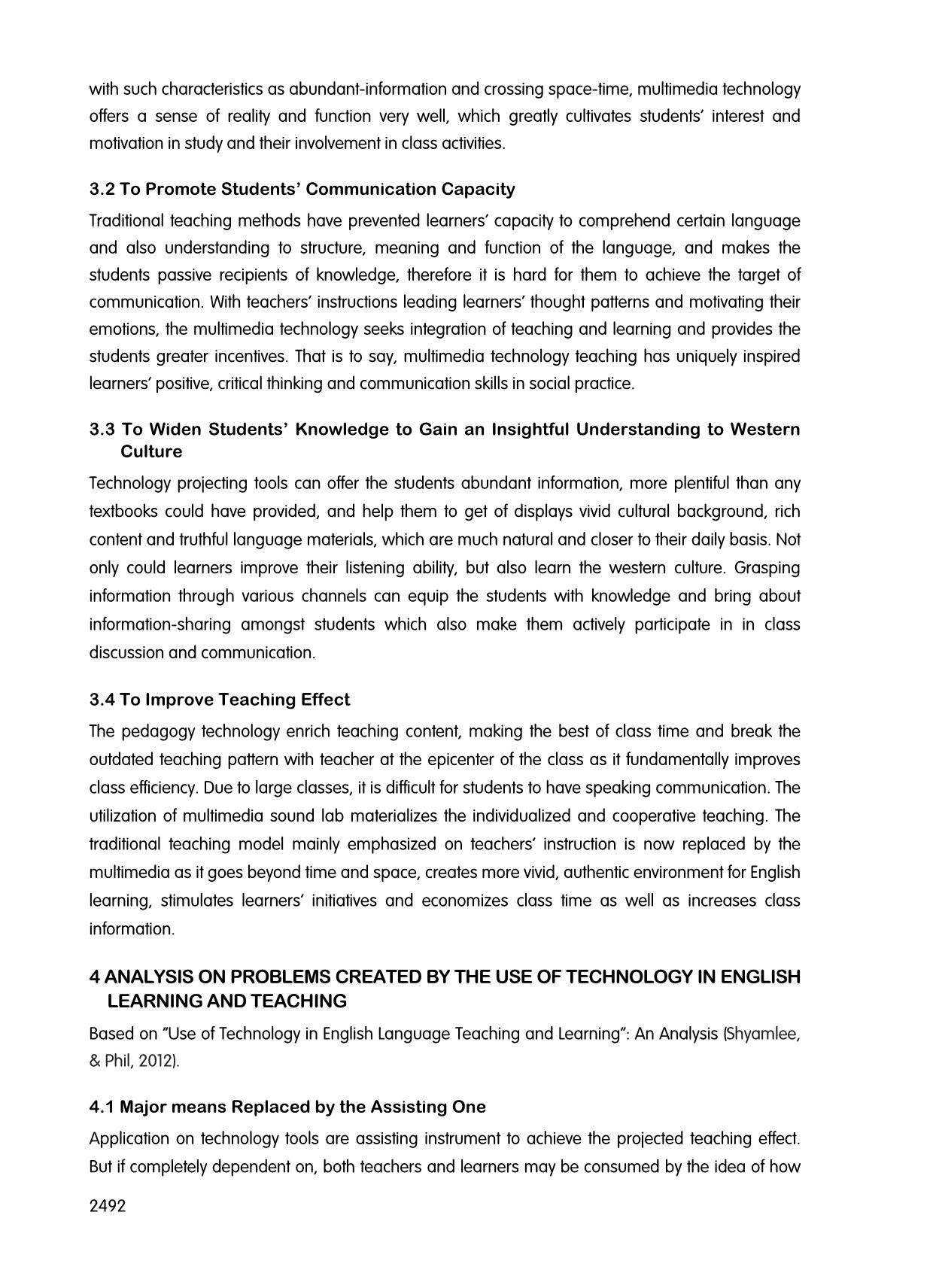
Trang 3
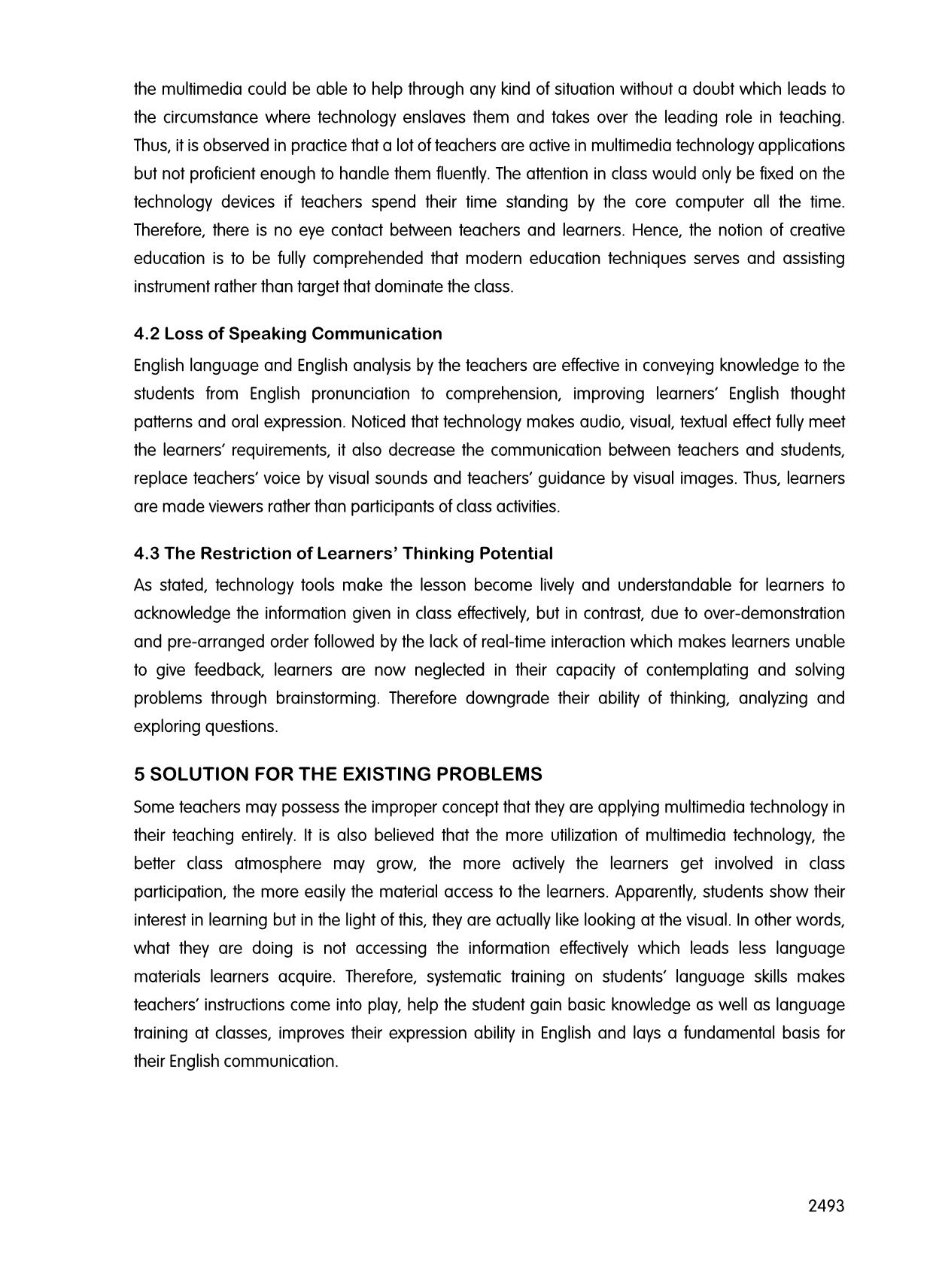
Trang 4
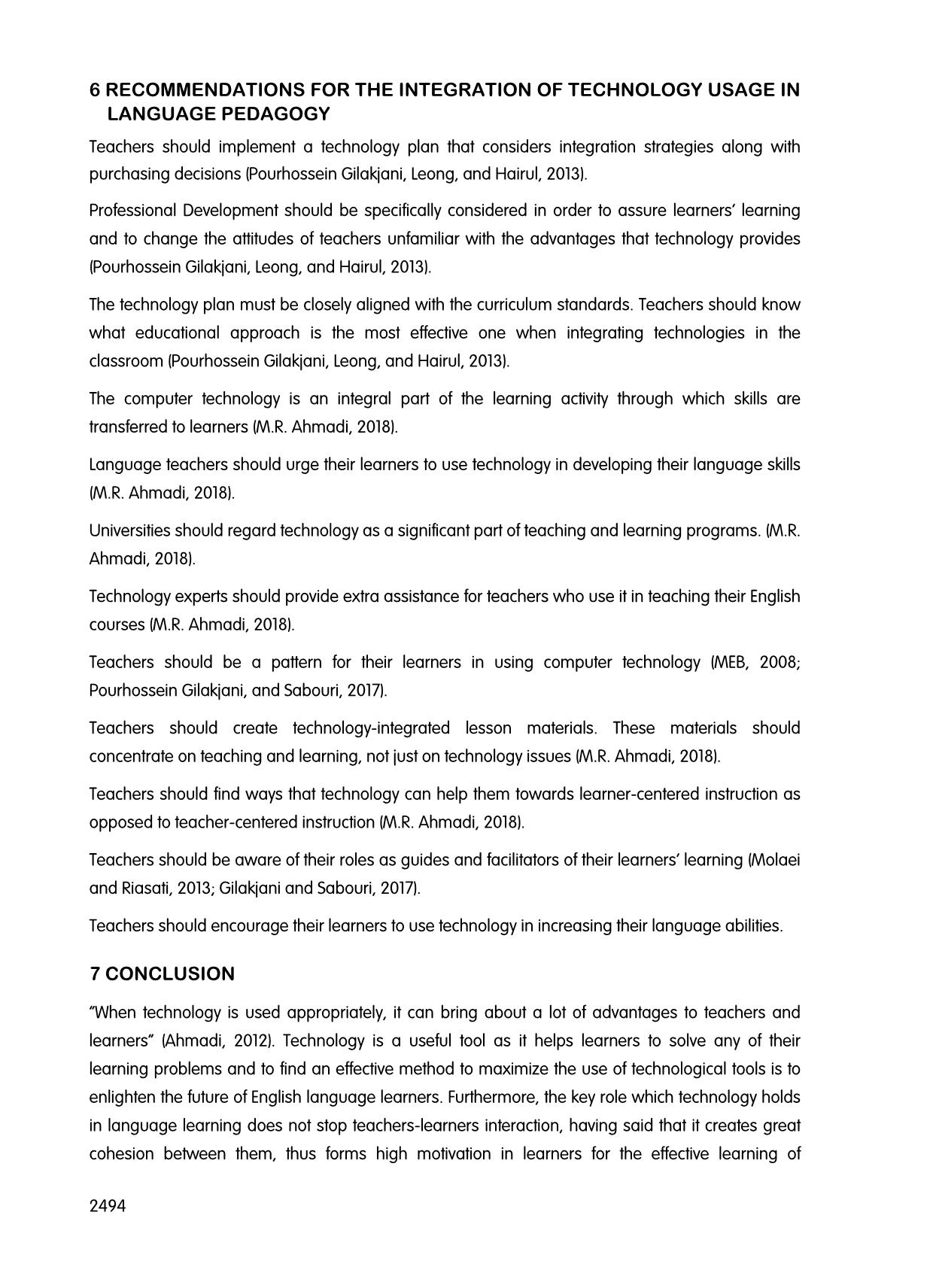
Trang 5
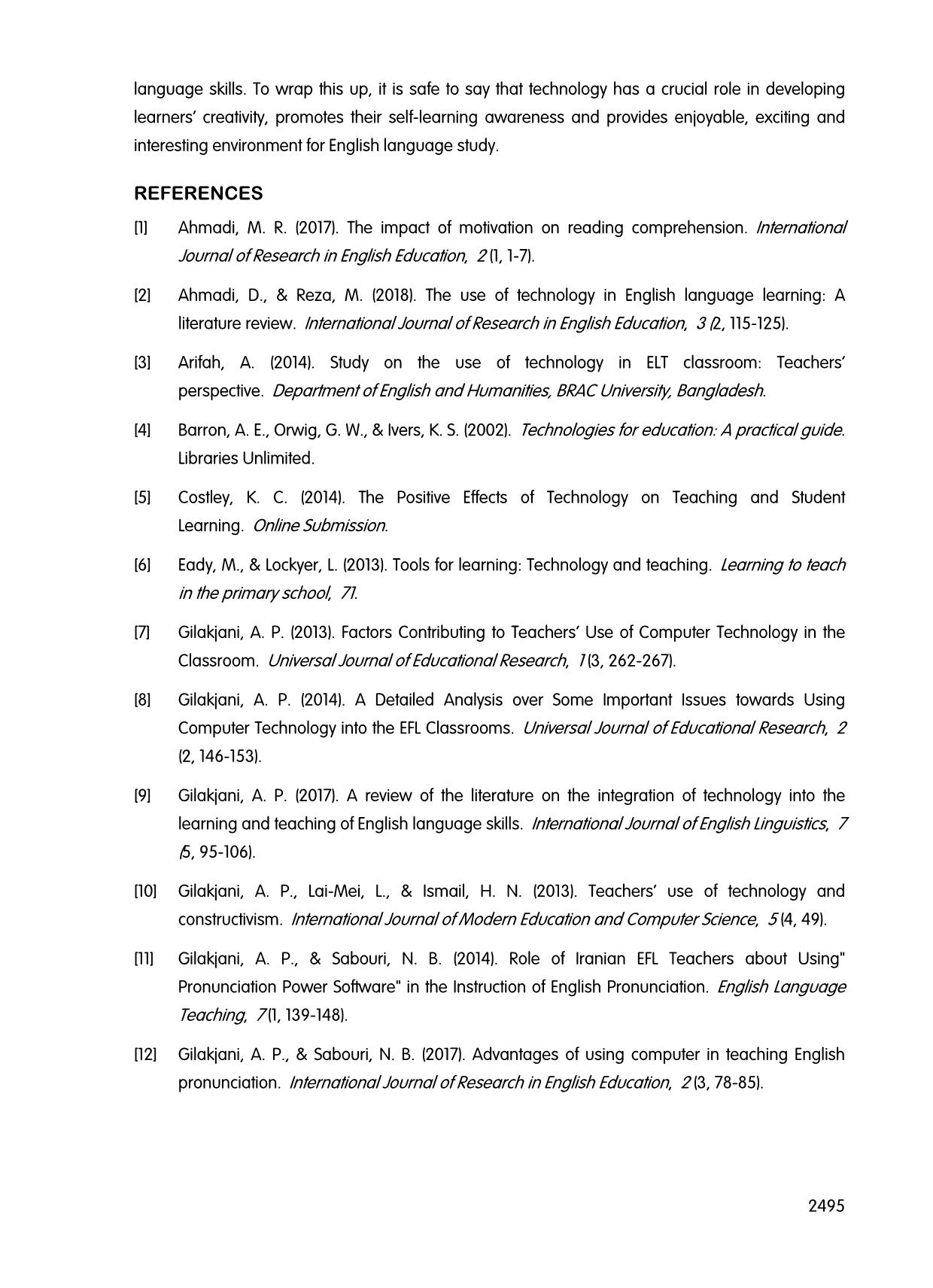
Trang 6
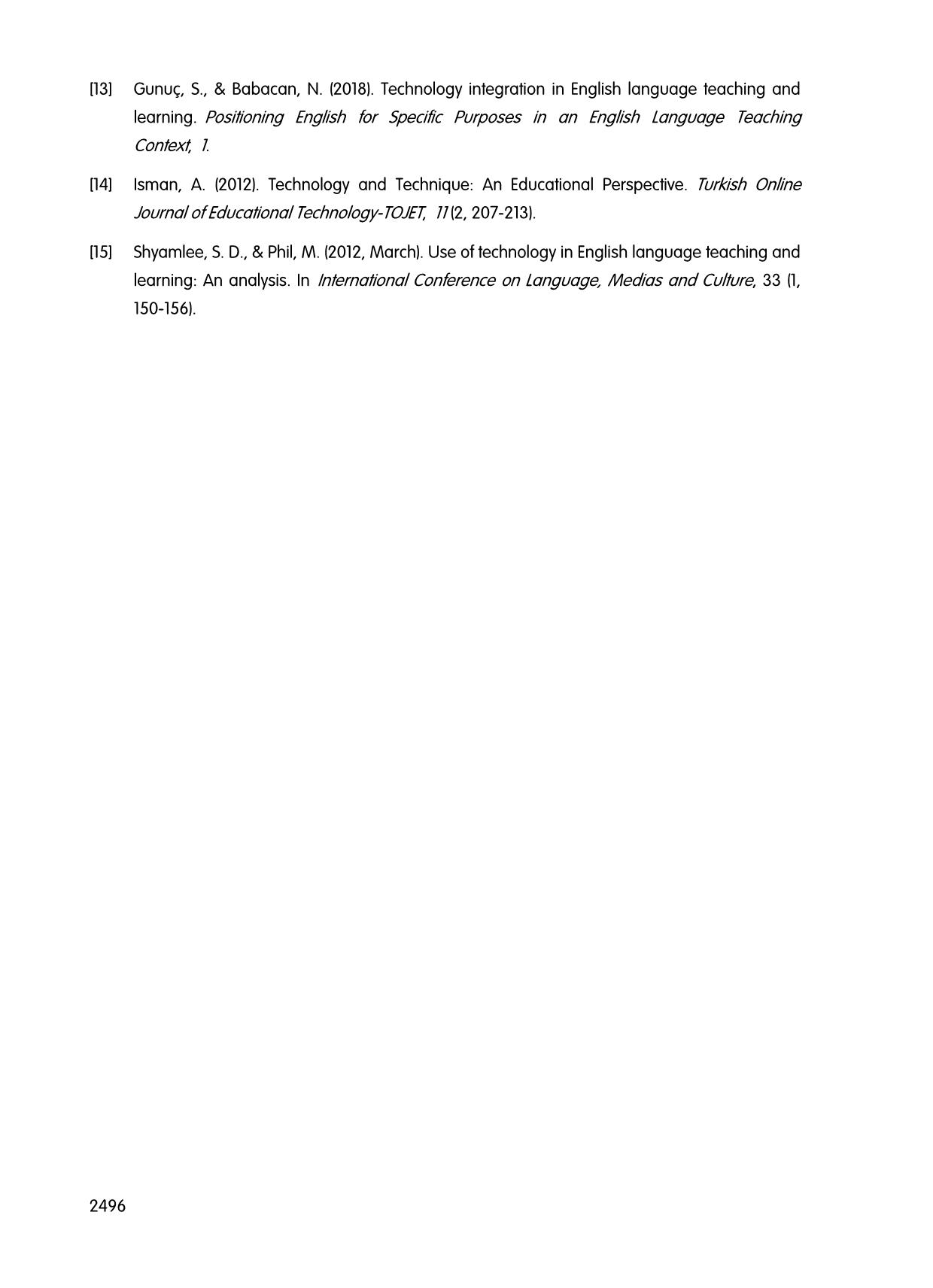
Trang 7
Tóm tắt nội dung tài liệu: The use of technology in english language teaching and learning
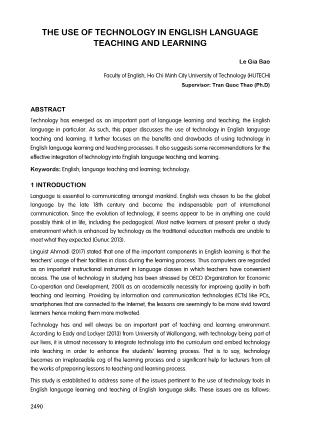
2490 THE USE OF TECHNOLOGY IN ENGLISH LANGUAGE TEACHING AND LEARNING Le Gia Bao Faculty of English, Ho Chi Minh City University of Technology (HUTECH) Supervisor: Tran Quoc Thao (Ph.D) ABSTRACT Technology has emerged as an important part of language learning and teaching; the English language in particular. As such, this paper discusses the use of technology in English language teaching and learning. It further focuses on the benefits and drawbacks of using technology in English language learning and teaching processes. It also suggests some recommendations for the effective integration of technology into English language teaching and learning. Keywords: English; language teaching and learning; technology. 1 INTRODUCTION Language is essential to communicating amongst mankind. English was chosen to be the global language by the late 18th century and became the indispensable part of international communication. Since the evolution of technology, it seems appear to be in anything one could possibly think of in life, including the pedagogical. Most native learners at present prefer a study environment which is enhanced by technology as the traditional education methods are unable to meet what they expected (Gunuc 2013). Linguist Ahmadi (2017) stated that one of the important components in English learning is that the teachers' usage of their facilities in class during the learning process. Thus computers are regarded as an important instructional instrument in language classes in which teachers have convenient access. The use of technology in studying has been stressed by OECD (Organization for Economic Co-operation and Development, 2001) as an academically necessity for improving quality in both teaching and learning. Providing by information and communication technologies (ICTs) like PCs, smartphones that are connected to the Internet, the lessons are seemingly to be more vivid toward learners hence making them more motivated. Technology has and will always be an important part of teaching and learning environment. According to Eady and Lockyer (2013) from University of Wollongong, with technology being part of our lives, it is utmost necessary to integrate technology into the curriculum and embed technology into teaching in order to enhance the students’ learning process. That is to say, technology becomes an irreplaceable cog of the learning process and a significant help for lecturers from all the works of preparing lessons to teaching and learning process. This study is established to address some of the issues pertinent to the use of technology tools in English language learning and teaching of English language skills. These issues are as follows: 2491 definition of technology, the use of technology in English learning and teaching, the development of English learning and teaching through technological tools, analysis on necessity of technology to English learning and teaching, analysis on problems created by the use of technology within the context, solutions for the existing problems, and some recommendations for integration of technology in English learning. 2 THE USE OF TECHNOLOGY IN ENGLISH LEARNING AND TEACHING Technology has been defined by thousands of researchers over half the century with many different ideas. However, at the intersection point of the prism, researchers agreed that it is the practical use of knowledge particularly in a specific field of profession and is a way of doing a task especially using technical processes, methods or knowledge. According to İŞMAN (2012), the usage of technology includes not only machines and parts of the computers’ sets, but also involves structured relations with others humans, mechanical facilities and the environment. Technological tools are really effective for learners for how diverse their utilities are. To support this hypothesis, Barron, Orwig, Ivers and Lilavois (2002) defined the benefits of technology uses in English language as ‚encourages students to learn actively, provides individual development & motivation, increases teachers-students interaction and helps them build cultural bridges‛. For better contrast, teachers should arrange the use of technology to support their teaching process so that learners can maximize the use of technology as they can interact with many different tools within the class (Costley, 2014; Murphy, DePasquale, and McNamara, 2003). Gilakjani (2014) stated that using technology can create a learning atmosphere with learner in the epicenter, rather than the teacher, which creates positive changes. Emphasized in the study, by using the technology, language classes become active places full of knowledge-related tasks for learners to pay more attention to the lessons. A study from Arifah (2014) showed that the use of internet is also incontrovertible as it increases learners’ motivation in diverse ways such as online media information which helps learners to know the topic with enthusiasm and excitement leading them to enhance their knowledge more effectively. When learners apply technology into their study, the assistance they receive for developing their skills is massively great. It is safe to say that technology combined to teaching methodology is utmost important to lure learners’ attention towards their track of language learning. 3 ANALYSIS ON NECESSITY OF TECHNOLOGY TO ENGLISH LEARNING AND TEACHING Based on ‚Use of Technology in English Language Teaching and Learning‛: An Analysis (Shyamlee, & Phil, 2012). 3.1 To Cultivate Students’ Interest in Study Nowadays, traditional teaching methods are ebbed while multimedia technology featuring audio, visual animation effects naturally and humanely makes us more access to information. Moreover, 2492 with such characteristics as abundant-information and crossing space-time, multimedia technology offers a sense of reality and function very well, which greatly cultivates students’ interest and motivation in study and their involvement in class activities. 3.2 To Promote Students’ Communication Capacity Traditional teaching methods have prevented learners’ capacity to comprehend certain language and also understanding to structure, meaning and function of the language, and makes the students passive recipients of knowledge, therefore it is hard for them to achieve the target of communication. With teachers’ instructions leading learners’ thought patterns and motivating their emotions, the multimedia technology seeks integration of teaching and learning and provides the students greater incentives. That is to say, multimedia technology teaching has uniquely inspired learners’ positive, critical thinking and communication skills in social practice. 3.3 To Widen Students’ Knowledge to Gain an Insightful Understanding to Western Culture Technology projecting tools can offer the students abundant information, more plentiful than any textbooks could have provided, and help them to get of displays vivid cultural background, rich content and truthful language materials, which are much natural and closer to their daily basis. Not only could learners improve their listening ability, but also learn the western culture. Grasping information through various channels can equip the students with knowledge and bring about information-sharing amongst students which also make them actively participate in in class discussion and communication. 3.4 To Improve Teaching Effect The pedagogy technology enrich teaching content, making the best of class time and break the outdated teaching pattern with teacher at the epicenter of the class as it fundamentally improves class efficiency. Due to large classes, it is difficult for students to have speaking communication. The utilization of multimedia sound lab materializes the individualized and cooperative teaching. The traditional teaching model mainly emphasized on teachers’ instruction is now replaced by the multimedia as it goes beyond time and space, creates more vivid, authentic environment for English learning, stimulates learners’ initiatives and economizes class time as well as increases class information. 4 ANALYSIS ON PROBLEMS CREATED BY THE USE OF TECHNOLOGY IN ENGLISH LEARNING AND TEACHING Based on ‚Use of Technology in English Language Teaching and Learning‛: An Analysis (Shyamlee, & Phil, 2012). 4.1 Major means Replaced by the Assisting One Application on technology tools are assisting instrument to achieve the projected teaching effect. But if completely dependent on, both teachers and learners may be consumed by the idea of how 2493 the multimedia could be able to help through any kind of situation without a doubt which leads to the circumstance where technology enslaves them and takes over the leading role in teaching. Thus, it is observed in practice that a lot of teachers are active in multimedia technology applications but not proficient enough to handle them fluently. The attention in class would only be fixed on the technology devices if teachers spend their time standing by the core computer all the time. Therefore, there is no eye contact between teachers and learners. Hence, the notion of creative education is to be fully comprehended that modern education techniques serves and assisting instrument rather than target that dominate the class. 4.2 Loss of Speaking Communication English language and English analysis by the teachers are effective in conveying knowledge to the students from English pronunciation to comprehension, improving learners’ English thought patterns and oral expression. Noticed that technology makes audio, visual, textual effect fully meet the learners’ requirements, it also decrease the communication between teachers and students, replace teachers’ voice by visual sounds and teachers’ guidance by visual images. Thus, learners are made viewers rather than participants of class activities. 4.3 The Restriction of Learners’ Thinking Potential As stated, technology tools make the lesson become lively and understandable for learners to acknowledge the information given in class effectively, but in contrast, due to over-demonstration and pre-arranged order followed by the lack of real-time interaction which makes learners unable to give feedback, learners are now neglected in their capacity of contemplating and solving problems through brainstorming. Therefore downgrade their ability of thinking, analyzing and exploring questions. 5 SOLUTION FOR THE EXISTING PROBLEMS Some teachers may possess the improper concept that they are applying multimedia technology in their teaching entirely. It is also believed that the more utilization of multimedia technology, the better class atmosphere may grow, the more actively the learners get involved in class participation, the more easily the material access to the learners. Apparently, students show their interest in learning but in the light of this, they are actually like looking at the visual. In other words, what they are doing is not accessing the information effectively which leads less language materials learners acquire. Therefore, systematic training on students’ language skills makes teachers’ instructions come into play, help the student gain basic knowledge as well as language training at classes, improves their expression ability in English and lays a fundamental basis for their English communication. 2494 6 RECOMMENDATIONS FOR THE INTEGRATION OF TECHNOLOGY USAGE IN LANGUAGE PEDAGOGY Teachers should implement a technology plan that considers integration strategies along with purchasing decisions (Pourhossein Gilakjani, Leong, and Hairul, 2013). Professional Development should be specifically considered in order to assure learners’ learning and to change the attitudes of teachers unfamiliar with the advantages that technology provides (Pourhossein Gilakjani, Leong, and Hairul, 2013). The technology plan must be closely aligned with the curriculum standards. Teachers should know what educational approach is the most effective one when integrating technologies in the classroom (Pourhossein Gilakjani, Leong, and Hairul, 2013). The computer technology is an integral part of the learning activity through which skills are transferred to learners (M.R. Ahmadi, 2018). Language teachers should urge their learners to use technology in developing their language skills (M.R. Ahmadi, 2018). Universities should regard technology as a significant part of teaching and learning programs. (M.R. Ahmadi, 2018). Technology experts should provide extra assistance for teachers who use it in teaching their English courses (M.R. Ahmadi, 2018). Teachers should be a pattern for their learners in using computer technology (MEB, 2008; Pourhossein Gilakjani, and Sabouri, 2017). Teachers should create technology-integrated lesson materials. These materials should concentrate on teaching and learning, not just on technology issues (M.R. Ahmadi, 2018). Teachers should find ways that technology can help them towards learner-centered instruction as opposed to teacher-centered instruction (M.R. Ahmadi, 2018). Teachers should be aware of their roles as guides and facilitators of their learners’ learning (Molaei and Riasati, 2013; Gilakjani and Sabouri, 2017). Teachers should encourage their learners to use technology in increasing their language abilities. 7 CONCLUSION ‚When technology is used appropriately, it can bring about a lot of advantages to teachers and learners‛ (Ahmadi, 2012). Technology is a useful tool as it helps learners to solve any of their learning problems and to find an effective method to maximize the use of technological tools is to enlighten the future of English language learners. Furthermore, the key role which technology holds in language learning does not stop teachers-learners interaction, having said that it creates great cohesion between them, thus forms high motivation in learners for the effective learning of 2495 language skills. To wrap this up, it is safe to say that technology has a crucial role in developing learners’ creativity, promotes their self-learning awareness and provides enjoyable, exciting and interesting environment for English language study. REFERENCES [1] Ahmadi, M. R. (2017). The impact of motivation on reading comprehension. International Journal of Research in English Education, 2 (1, 1-7). [2] Ahmadi, D., & Reza, M. (2018). The use of technology in English language learning: A literature review. International Journal of Research in English Education, 3 (2, 115-125). [3] Arifah, A. (2014). Study on the use of technology in ELT classroom: Teachers’ perspective. Department of English and Humanities, BRAC University, Bangladesh. [4] Barron, A. E., Orwig, G. W., & Ivers, K. S. (2002). Technologies for education: A practical guide. Libraries Unlimited. [5] Costley, K. C. (2014). The Positive Effects of Technology on Teaching and Student Learning. Online Submission. [6] Eady, M., & Lockyer, L. (2013). Tools for learning: Technology and teaching. Learning to teach in the primary school, 71. [7] Gilakjani, A. P. (2013). Factors Contributing to Teachers' Use of Computer Technology in the Classroom. Universal Journal of Educational Research, 1 (3, 262-267). [8] Gilakjani, A. P. (2014). A Detailed Analysis over Some Important Issues towards Using Computer Technology into the EFL Classrooms. Universal Journal of Educational Research, 2 (2, 146-153). [9] Gilakjani, A. P. (2017). A review of the literature on the integration of technology into the learning and teaching of English language skills. International Journal of English Linguistics, 7 (5, 95-106). [10] Gilakjani, A. P., Lai-Mei, L., & Ismail, H. N. (2013). Teachers' use of technology and constructivism. International Journal of Modern Education and Computer Science, 5 (4, 49). [11] Gilakjani, A. P., & Sabouri, N. B. (2014). Role of Iranian EFL Teachers about Using" Pronunciation Power Software" in the Instruction of English Pronunciation. English Language Teaching, 7 (1, 139-148). [12] Gilakjani, A. P., & Sabouri, N. B. (2017). Advantages of using computer in teaching English pronunciation. International Journal of Research in English Education, 2 (3, 78-85). 2496 [13] Gunuç, S., & Babacan, N. (2018). Technology integration in English language teaching and learning. Positioning English for Specific Purposes in an English Language Teaching Context, 1. [14] Isman, A. (2012). Technology and Technique: An Educational Perspective. Turkish Online Journal of Educational Technology-TOJET, 11 (2, 207-213). [15] Shyamlee, S. D., & Phil, M. (2012, March). Use of technology in English language teaching and learning: An analysis. In International Conference on Language, Medias and Culture, 33 (1, 150-156).
File đính kèm:
 the_use_of_technology_in_english_language_teaching_and_learn.pdf
the_use_of_technology_in_english_language_teaching_and_learn.pdf

